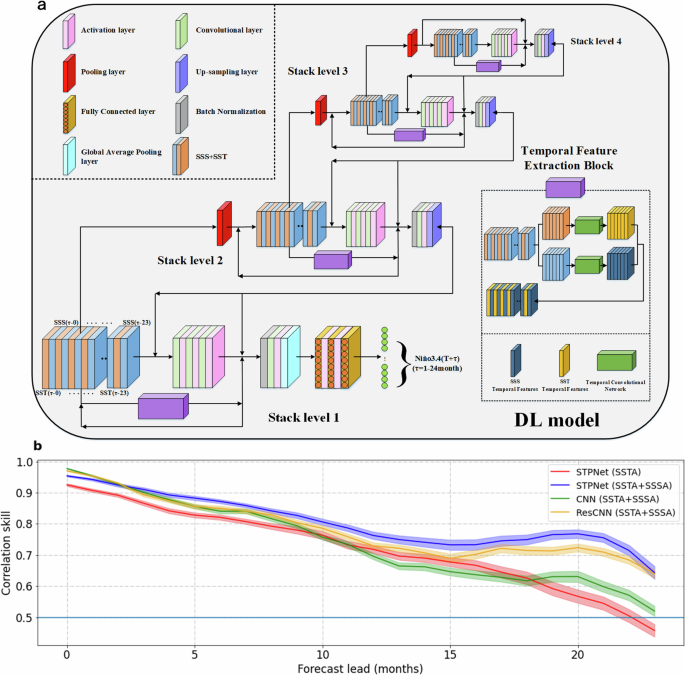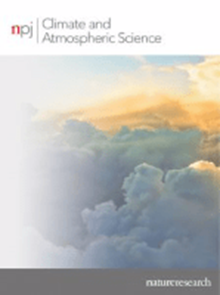The role of sea surface salinity in ENSO forecasting in the 21st century
IF 8.5
1区 地球科学
Q1 METEOROLOGY & ATMOSPHERIC SCIENCES
引用次数: 0
Abstract
Significant strides have been made in understanding El Niño-Southern Oscillation (ENSO) dynamics, yet its long-lead prediction remains challenging, especially for the El Niño events after 2000. Sea surface salinity (SSS) is known to affect ENSO development and intensity by influencing ocean stratification and heat redistribution and therefore, when combined with sea surface temperature (SST) data, can potentially enhance ENSO forecast skill. In this study, we develop a deep learning (DL) model that incorporates a multiscale-pyramid structure and spatiotemporal feature extraction blocks, and the model successfully extends effective ENSO forecast lead time to 24 months for 2000–2021 with reduced effect of the spring predictability barrier (SPB). Interpretable methods are then applied to reveal the time-dependent roles of SST and SSS in ENSO forecast. More specifically, SST is critical for short-medium lead forecasts (<1 year), while SSS is important for medium-long lead forecasts (>6 months). Furthermore, we track global SST and SSS spatiotemporal shifts related to subsequent ENSO development, highlighting the importance of ocean inter-basin and tropics-extratropics interactions. With increasing availability of satellite SSS observations, our findings unveil unprecedented potential for advancing ENSO long-lead forecast skills.


海面盐度在 21 世纪厄尔尼诺/南方涛动预报中的作用
人们在了解厄尔尼诺-南方涛动(ENSO)动力学方面取得了长足进步,但对其进行长期预测,特别是对 2000 年以后的厄尔尼诺现象进行预测,仍然具有挑战性。众所周知,海表盐度(SSS)通过影响海洋分层和热量再分布来影响厄尔尼诺/南方涛动的发展和强度,因此,如果与海表温度(SST)数据相结合,有可能提高厄尔尼诺/南方涛动的预测能力。在这项研究中,我们开发了一种深度学习(DL)模型,该模型结合了多矢量金字塔结构和时空特征提取块,该模型成功地将 2000-2021 年厄尔尼诺/南方涛动的有效预报提前期延长至 24 个月,并减少了春季可预测性障碍(SPB)的影响。然后,应用可解释的方法揭示了 SST 和 SSS 在厄尔尼诺/南方涛动预报中随时间变化的作用。更具体地说,SST 对中短期预报(1 年)至关重要,而 SSS 对中长期预报(6 个月)非常重要。此外,我们还跟踪了与后续厄尔尼诺/南方涛动发展相关的全球 SST 和 SSS 时空变化,强调了海洋盆地间和热带-外热带相互作用的重要性。随着卫星 SSS 观测资料的不断增加,我们的研究结果为提高厄尔尼诺/南方涛动的长时效预报能力揭示了前所未有的潜力。
本文章由计算机程序翻译,如有差异,请以英文原文为准。
求助全文
约1分钟内获得全文
求助全文
来源期刊

npj Climate and Atmospheric Science
Earth and Planetary Sciences-Atmospheric Science
CiteScore
8.80
自引率
3.30%
发文量
87
审稿时长
21 weeks
期刊介绍:
npj Climate and Atmospheric Science is an open-access journal encompassing the relevant physical, chemical, and biological aspects of atmospheric and climate science. The journal places particular emphasis on regional studies that unveil new insights into specific localities, including examinations of local atmospheric composition, such as aerosols.
The range of topics covered by the journal includes climate dynamics, climate variability, weather and climate prediction, climate change, ocean dynamics, weather extremes, air pollution, atmospheric chemistry (including aerosols), the hydrological cycle, and atmosphere–ocean and atmosphere–land interactions. The journal welcomes studies employing a diverse array of methods, including numerical and statistical modeling, the development and application of in situ observational techniques, remote sensing, and the development or evaluation of new reanalyses.
 求助内容:
求助内容: 应助结果提醒方式:
应助结果提醒方式:


